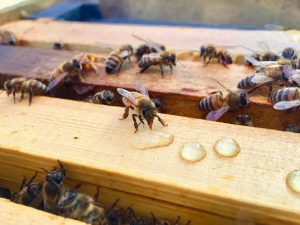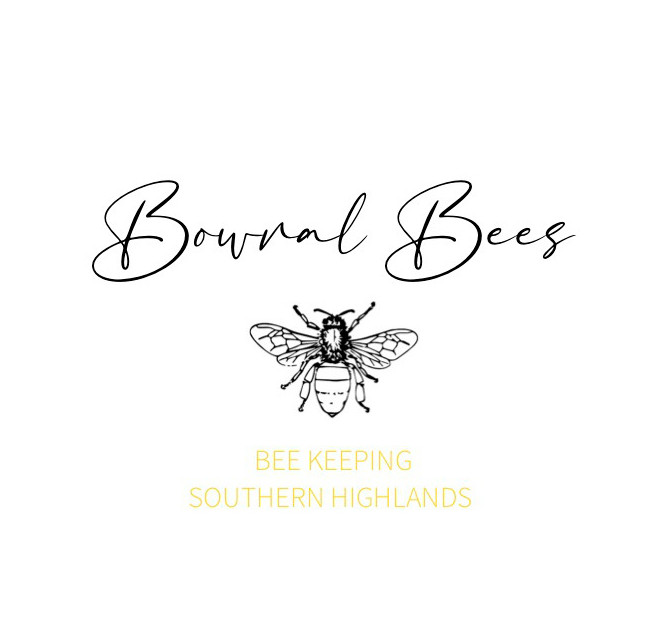Feeding Bees

There is nothing healthier for your bees than their own honey, or nectar and pollen they can collect from a source of flora nearby to the hive… but there are times when feeding your bees is required to maintain hive health, boost numbers, or in the very worst case, ensure the colony survives at all!
The type and amount of feed you provide depends on what you’re trying to achieve so read on to find out the details on feeding your bees.
Pre-Winter Feeding
If your hive is assessed to be low on resources in Autumn then pre-Winter feeding is recommended (don’t wait until Winter, do it right away!). The aim is to get the hive to a point where they’ll have enough resources to survive Winter and this depends a lot on your region and the climate you have.
In the Southern Highlands we get fairly cold Winters with frequent frosts so I aim to have all my hives packed down to 2 x 8 frame boxes and for the super to have 5-6 frames of full honey and 2-3 frames half full. During pack down I also check the outside brood box frames are full or if not replace these with honey frames from the super.
Pre-Winter feeding is best done with syrup made 2:1 (by volume) white sugar : water. This syrup is like honey to the bees and they will take the syrup from the feeder and store it in the comb. Approximately 1 frame of honey is equivalent to 2.5kgs of sugar.
I make syrup in 3L plastic milk cartons and pour / funnel in dry white sugar from a 2kg bag. I add 1 litre of hot water from the tap and then shake it all vigorously to dissolve all the sugar. Measure accurately the first time you make this mix but then mark the carton so you don’t need to measure next time. Milk cartons are great to use as it’s easy to shake and mix in the sugar, plus very easy to pour the syrup into a feeder at the hive.

Square top feeder 
Off to feed the bees! 
Top feeder
With syrup feeding you’ll need either a frame or top feeder (see photos above). Either are fine – a frame feeder just requires you remove a frame from the hive and open the hive each time you add syrup. Whereas a top feeder place on an inner cover / crown board can be topped up without disturbing the hive. Crown boards are also great to add a layer of insulation on top of the hive after you’re done feeding (see my article on Wintering Bees)
You should continue feeding until your bees have the right amount of resources to survive Winter.
Feeding for health / poor weather / low nectar flow
If your bees are unwell / stressed in any way (eg chalkbrood, low bee numbers), or are affected by bad weather (eg drought, or rain for weeks on end!), or simply have a dearth in local resources to forage on, then a supplementary feed will help them out.
In any of these situations I’d recommend feeding syrup made 1:1 (by volume) white sugar : water. This syrup is like nectar and not only provides immediate food for the hive but it can stimulate the queen to lay more eggs, which will then boost hive numbers.

Inner cover with small hole 
Round feeder is placed over the hole 
Feeder on hive filled with syrup
I use either a frame feeder placed inside the hive (usually for one box hives) or a top feeder placed on an inner cover / crown board. Top feeders I find preferable as you can top up the syrup without disturbing the bees at all… so you don’t need to wear a full suit to feed – I usually wear gloves and a jacket or veil.
Small regular feeding of syrup will give the hive immediate resources to keep warm and build up their numbers, so this can be a good counter to poor health, low numbers, or a sudden cold / wet period of weather. I prefer to feed in the late afternoon which reduces the risk of robbing from other hives, plus the bees will work through the night moving the syrup down into the hive.
Note that in the case of poor health you should do a thorough inspection to determine if the hive is being affected by any pests or disease.
Winter Feeding
It’s better for your hive to have ample resources heading into Winter, or for you to have fed your hive before Winter arrives. But if they’re still low on resources you should switch from syrup to ‘dry feeding’ your bees.
Dry feed can help absorb moisture or condensation and is done by placing sugar directly on top of a hive mat (which is placed on top of frames) or crown board. A better alternative to using loose sugar are sugar cakes.
Sugar cakes are easy to make – I use a 2kg bag of white sugar mixed in a large pot with 200-300ml of hot water. Stir thoroughly for a few minutes and you should get a slightly firm mixture. Some people add essential oils at this time such as lavender or lemongrass with the idea the bees will find or like the cake more, or even add pollen / pollen substitute.

A mix of sugar & water 
Place the mix in a shallow tray 
Press it down firmly to make a ‘cake’
Scoop the mix into a shallow tray and press it down firmly to make a dense flat ‘cake’. The height of the cake could be matched to the internal space of your hive lid height. You can scribe a line to make it easier to break in half later. Place the tray(s) into an oven set on a low temperature (I set our oven at around 80-100 C) and bake for 1-2 hours until the cake is firm.
You can then store the cakes in a sealed tub until you can place them into the hive. When adding to a hive the cakes are best place above the brood nest but are fine on top of the super frames. If your lid has a decent internal space (eg 30-50mm) then you can add the cakes directly on top of the frames, but if don’t have the height you could use a shim / spacer, or use a crown board / inner cover and place the cakes on top of this.

Cakes made! 
Sugar cakes placed into a hive on top of frames
Late Winter / early Spring feeding
Towards the end of Winter the queen will start laying more eggs in anticipation of the Spring blossoms. As such the food demands of the hive starts to increase significantly… but this is before the blossoms have started and after a long Winter there may not be a lot of resources left, so the hive can be in danger of starvation at this time.
You should do a check of your hive in late Winter (= mid to late August in the Southern Highlands) to assess their resources. This could mean briefly opening the hive up on a warmish sunny day or simply hefting (lifting) or weighing the hive to assess it’s weight (it’s best to have a comparison weight of the hive from before Winter).
If you find they’re low on resources then a later Winter / early Spring feed of 1:1 syrup will prevent starvation at this critical time of the year. This syrup will also stimulate the queen to lay more eggs and therefore build up numbers. Just be aware this will further increase the demand for food and could increase the risk of early swarming.
Feeding splits or nuc bee hives
When you’re raising a new queen via a split or introducing a mated queen it’s important the hive has all the resources they need. So feeding syrup 1:1 at this time is ideal. It will produce better queens if the bees are raising their own, or increase the likelihood of acceptance of the introduced queen.

2 Comments
Pingback:
Pingback: